Why do some Nepali people look like the Chinese?
为什么有些尼泊尔人长得像中国人?
以下是Quora网友的评价:
MK Subba
Nepal lies between the plain of Ganga (in the south) and the Tiban plateau (in the north). Since prehistoric times, people from both directions have been migrating to the mountainous land between the plain and the plateau in search of livelihood and to escape religious and political persecution.
尼泊尔位于恒河平原(南部)和青藏高原(北部)之间。从史前时代起,为了寻求生计和逃避宗教和政治迫害,两岸的人们就开始向平原和高原之间的山区迁移。
The ancestors of Mongoloid people (Rai, Limbu, Gurung, Magar, Tamang, Sherpa, etc.) came from the north and east. Gurung, Tamang and Sherpa came straight from the north (Tib); their language and culture reflect their Tiban origin. People of east Nepal who collectively identify themselves as Kiraat people (Rai, Limbu, Sunuwar, Lepcha, etc.) probably came from China via northeast India and Myanmar. All these people look similar to (but not exactly like) the Chinese: generally round face, hairless body, fair complexon, short nose, and slitty eyes.
The ancestors of Aryan people (Bahun [Brahman], Chhetri [Kshetria], Kaami, Damaai, Madhesis, etc.) came from the south and west. The ancestors of Bahuns (of both the hills and plains) came from the south (mostly Bihar and Uttar Pradesh India). Hill Chhetris claim that their ancestors came from Iran via Afghanistan, Pakistan and Kashmir. But many of them also trace their ancestry to the Rajputs of India’s western state Rajasthan. There are also Muslims and a small number of Sikhs in Nepal. In any case, it can be said that most of them came from India. All of these people look similar to Indians: generally long face, hairy body, dark complexon, big nose, and wide and deep-set eyes.
蒙古人的祖先(Rai, Limbu, Gurung, Magar, Tamang, Sherpa等)来自北方和东方。古隆、塔芒和夏尔巴人直接来自北方(xz);他们的语言和文化反映了他们的藏族血统。东尼泊尔人统称为克拉特人(Rai, Limbu, Sunuwar, Lepcha等),可能是通过印度东北部和缅甸从中国来的。所有这些人看起来都很像(但不完全像)中国人:一般都是圆脸、无毛、白皙的肤色、短鼻子和裂缝状的眼睛。
雅利安人的祖先(Bahun[婆罗门],Chhetri [Kshetria], Kaami, Damaai, Madhesis等)来自南部和西部。巴匈奴人(山区和平原)的祖先来自南方(主要是比哈尔邦和印度北方邦)。Hill Chhetris声称他们的祖先来自伊朗,途经阿富汗、巴基斯坦和克什米尔。但他们中的许多人的祖先也可以追溯到印度西部拉贾斯坦邦的拉吉普特人。尼泊尔也有msl和少数锡克教徒。无论如何,可以说他们中的大多数来自印度。所有这些人看起来都和印度人相似:通常是长脸,多毛的身体,黑肤色,大鼻子,宽而深的眼睛。
The Newars of Kathmandu valley are a hybrid of Mongoloid and Aryan people. Some of them look Mongoloid and some look Aryan, but most look mixed. But they all speak the same language (a Tibo-Burman language), have the same culture, and celebrate the same festivals.
A group of Rai girls in their traditional costume celebrating their festival Sakela:
加德满都谷地的纽瓦尔人是蒙古人和雅利安人的混血儿。有些人看起来像蒙古人,有些人看起来像雅利安人,但大多数人看起来是混血儿。但他们都说同样的语言(藏缅语),有同样的文化,庆祝同样的节日。
一群穿着传统服装的拉伊女孩庆祝他们的节日Sakela。
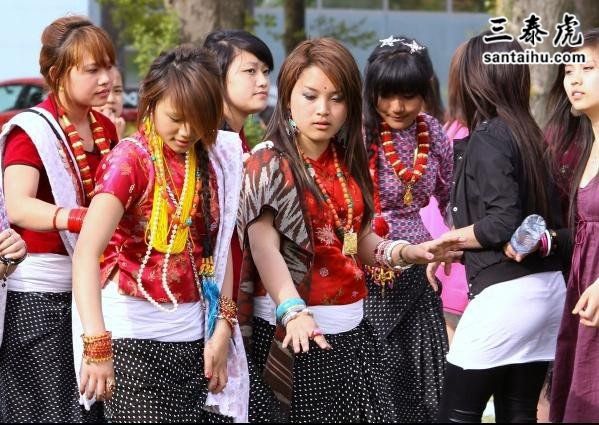
A Limbu man with some Limbu girls celebrating their festival Chasok Tangnam:
一名林布男子和一些林布女孩在庆祝他们的节日:
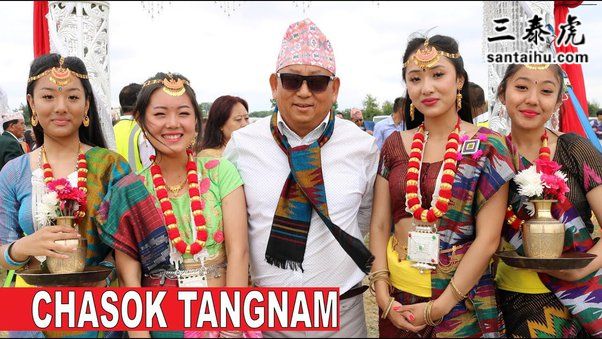
A group of Gurung girls in their traditional costume celebrating Tamu Lhosar (their version of Chinese/Tiban new year):
一群穿着传统服装的古隆女孩在庆祝塔木年(他们版本的中国西 藏新年)。
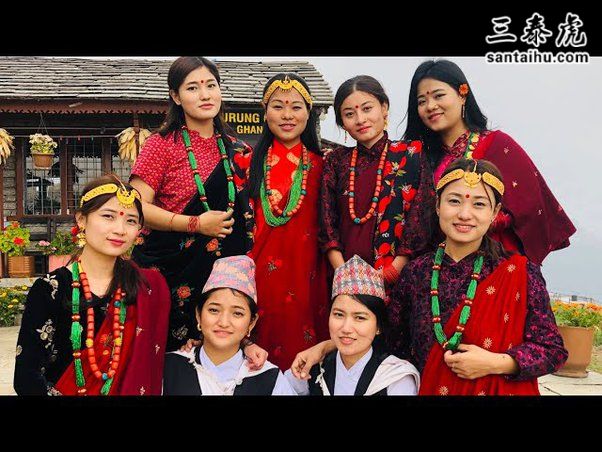
A group of Gurung girls in their traditional costume celebrating Tamu Lhosar (their version of Chinese/Tiban new year):
一群穿着传统服装的古隆女孩在庆祝塔木年(他们版本的中国西 藏新年)。

A group of Magar girls in their traditional attire:
一群穿着传统服装的玛加尔女孩:
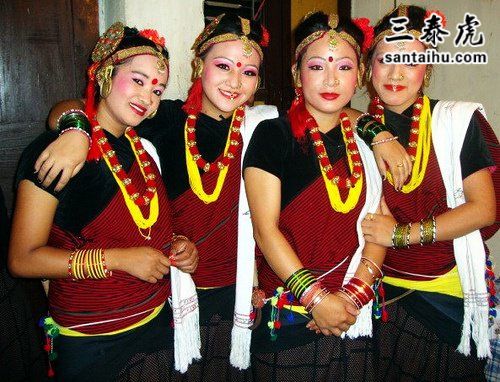
A group of Magar girls in their traditional attire:
一群穿着传统服装的玛加尔女孩:

A group of Bahun and Chhetri girls in their traditional attire:
一群穿着传统服装的巴洪和切特里女孩:

A group of Bahun and Chhetri women in their customary red sari and choli (blouse) celebrating the festival of Teez:
一群Bahun和Chhetri妇女穿着传统的红色纱丽和choli(罩衫)庆祝Teez节。
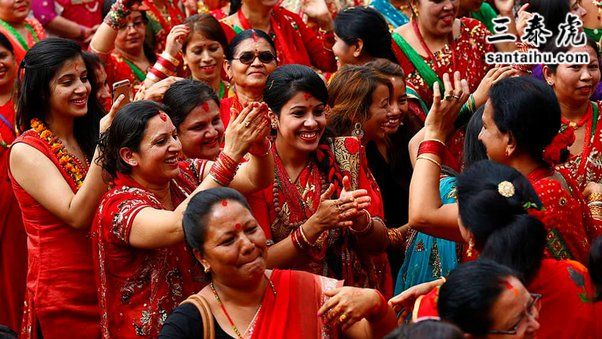
A group of Newar ladies (of various ages) in their traditional costume:
穿着传统服装的一群(不同年龄的)纽瓦妇女:

Madhesi (of the plain) girls playing the spring festival of Holi:
马德西(平原的)女孩玩春节的胡里节;
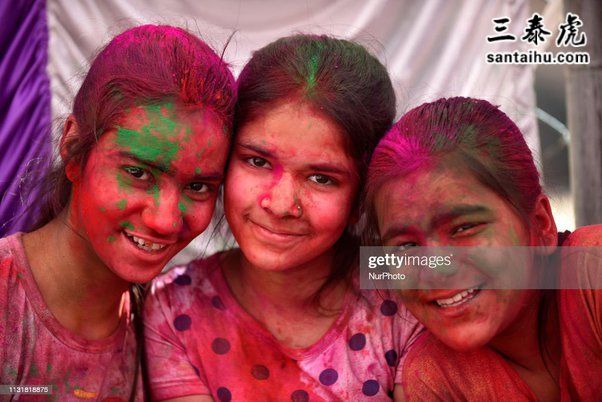
Muslim girls:
msl女孩:

Nepalese like to say that Nepal is a garland of a hundred different flowers. The number of mixed race Nepalis are increasing, because inter-race and inter-caste marriages have become common and widely accepted.
尼泊尔人喜欢一个说法:尼泊尔是百花编成的花环。各种族间和种姓间的通婚十分普遍,得到了广泛的接纳,尼泊尔的混血人数越来越多了。
Ma Nepali
In my opinion, all Nepalis originate from different parts of Nepal. In the prehistoric era, Nepalese civilization was started. The Mahabharata Parbat civilization, the Terai civilization, and the Himalayan civilization e.g., the Yeti and different types of fossils found in Nepal. Yeti fossil means it's a DNA match on humanoids.
在我看来,尼泊尔人来自尼泊尔的不同地区。尼泊尔文明从史前时期就开始出现了。摩诃婆罗多帕尔巴特文明、特赖文明和喜马拉雅文明,比如尼泊尔出土的雪人和各类化石。雪人化石的DNA与类人生物吻合。
WORKDONEG
The physical similarities between some Nepali people and Chinese people can be attributed to historical and genetic factors resulting from ancient migration patterns and interactions between different populations in the region.
有些尼泊尔人和中国人在外形上的相似可以归因于古代人类迁徙和该地区不同人群之间的融合所造成的历史和遗传因素。
Shared Ancestry and Migration: Both Nepali and Chinese populations are part of the broader Asian ethnic and genetic diversity. The ancestors of modern humans originated in Africa and began migrating to different parts of the world, including Asia, tens of thousands of years ago. Over millennia, human populations in Asia developed distinct genetic lineages through both isolation and migration.
共同的祖先和移民:尼泊尔和中国人口都是泛亚洲民族和遗传多样性的组成部分。现代人类的祖先起源于非洲,并在数万年前开始向包括亚洲在内的世界各地迁徙。几千年来,亚洲人因为孤立和迁徙逐渐形成了独特的遗传谱系。
Ancient Trade and Cultural Connections: The Himalayan region, where Nepal is located, has been a historical crossroads for trade and cultural exchange between South Asia and East Asia. There were interactions and migrations of people between these regions, leading to some degree of genetic mixng.
Geographic Proxmity: Nepal shares borders with China to the north, and their geographic proxmity has allowed for interactions and genetic exchange between the two populations over time.
古代贸易和文化联系:尼泊尔所在的喜马拉雅地区一直是南亚和东亚之间贸易和文化交流的历史交汇地。这些地区之间存在着人类的往来和迁徙,导致了某种程度的基因混合。
地理相邻:尼泊尔北部与中国接壤,地理上的相邻让两个种群之间的往来和基因交流成为可能。
Environmental Adaptations: Certain physical features, including facial features, can be influenced by environmental factors, such as climate and altitude. People living in similar geographical regions may develop similar physical traits as adaptations to their environment.
It's important to recognize that human genetic diversity is complex and does not follow strict national or geographical boundaries. Physical appearance can vary widely within any ethnic group, including Nepali and Chinese populations, due to the blending of genetic traits over generations.
环境适应:包括面部特征在内的某些外形特征会受到气候和海拔等环境因素的影响。生活在相似地理区域的人们可能会进化出相似的身体特征来适应环境。
我们要认识到人类遗传的多样性十分复杂,并不受国家或地理界限的严格限制。由于世代遗传特征的混合,所有民族都会存在较大的外貌差异,尼泊尔人和中国人也是如此。
Moreover, the term "Nepali" encompasses a diverse population with numerous ethnic groups and cultural backgrounds, and not all individuals within Nepal or China share the same physical traits. People's appearances are influenced by a combination of genetic heritage, environmental factors, and individual variation.
Celebrating and respecting the diversity of human appearances and acknowledging the uniqueness of each culture and community are essential in promoting understanding and inclusivity among all people.
此外,“尼泊尔人”一词也包含了众多民族和文化背景的人口,并非所有尼泊尔人和中国人都具有相同的外形特征。人的外貌会受到遗传、环境因素和个体差异的综合影响。
庆祝和尊重人类外貌的多样性,承认每种文化和社区的独特性,对于促进所有人之间的理解和包容至关重要。
Nepalify
I have heard a lot of Indians Friends
Why do all Nepalese look alike same
Saare ek jaise dikhatee ho Tum log
why do you look like chinese ?
Kind of Stereoty
Let be clear :
Nepal is a multi-religious, multi-ethnic and multi-racial country, all live together. Mainly two types of racial people live in Nepal.
我听很多印度朋友说过
为什么所有尼泊尔人都长得一样?
你为什么看起来像中国人?
这是一种刻板印象
我们必须先明确一点:
尼泊尔是一个多宗教、多民族、多种族并存的国家,尼泊尔境内主要生活着两个种族。
*Aryans*
*Mongolian*
Aryans is the one in whom facial features are found like (mostly Indians) because it would be wrong to say that all Indians are Arya so yeah we Nepalese Aryan looks like majority of indians;
*雅利安人*
*蒙古人*
雅利安人的面部特征是相似的(主要是印度人),因为所有印度人都是雅利安人的说法是错的,所以没错,我们尼泊尔的雅利安人看起来和大多数印度人很像;
Nepal's aborigines Rai Kirat Gurung Tamang mountain tribes look like Tibans. Marriages between Aryans and Mongolians have been happening in Nepal for centuries, that's why sometimes Aryan Rajputs like Malla Thapa Thakuri are found in mixed forms.
Aayushman Joshi Newar community Which believed Aryans and Mongolian mixed Looks
At last in Nepal we don't care about Mongolian or Aryans we just love each other cultures and way of life
尼泊尔的原住民Rai Kirat Gurung Tamang等山地部落看起来很像藏人。雅利安人和蒙古人之间在尼泊尔已经通婚了几个世纪,所以有时像马拉塔帕塔库里这样的雅利安拉杰普特人会有混血长相。
尼瓦尔人也有雅利安人和蒙古人的混血长相。
最后,在尼泊尔,我们不关心谁是蒙古人,谁是雅利安人,我们热爱彼此的文化和生活方式。
Easternsky
I once traveled from northern India (note not north eastern India) over the mountains into Nepal (i’m British). I didn’t really have much of an idea in my mind about Nepal or Nepalese people, and i was quite surprised when inside Nepal i seen not only people who looked typically north Indian as expected but also many who to me at the time looked Chinese/far eastern.
It turns out that Nepal along with northeast India is one of the transition zones between the Caucasian (west Eurasian phenotype) and the Mongolian (east Eurasian phenotype), with some people clearly having a mixed ancestry.
I know some Filipinos who have on several occasions been asked by Indian people if they are Nepalese.
我曾经从印度北部(注意不是印度东北部)翻山越岭进入尼泊尔(我是英国人)。我对尼泊尔或尼泊尔人并没有太多的想法,当我在尼泊尔看到预想中的北印度人长相的人,以及很多中国人或远东人长相的人时,我感到非常惊讶。
事实证明,尼泊尔和印度东北部主要是高加索人(西欧亚表型)和蒙古人(东欧亚表型)之间的过渡地带之一,有些人拥有混合血统。
我认识一些菲律宾人,他们也常会被印度人问是不是尼泊尔人。
Hu inqin
These people probably share ancestry or just coincidentally share physical traits typically associated with Chinese people. The Chinese are themselves a rather large, heterogenous group as well.
The population of Nepal come from a variety of other backgrounds as well.
So short answer, probably because they have some ancestors from China, or other related regions.
Or, they use makeup or plastic surgery.
这些人可能有共同的祖先,或者只是碰巧有中国人的相貌特征。中国人本身也是一个庞大的多民族群体。
尼泊尔人也有着广泛多样的背景。
所以简单说的话,可能是因为他们有些祖先来自中国或其他相关地区。
或者,他们用了化妆品或做了整形手术。
Motsuthung Yanthan
Everyone has talked about diversity and what not but not the obvious point.
We have to understand the fact that boundaries were not made based on looks and appearance. 100% of the people in this world were nomads long long ago. They all travelled from one place to another for food, and settled down and multiplied. Humans spreaded around the world then only, a political element came about in the name of “boundary”.
Now if you look at a world map, towards Nepal, Tib is Right There.
每个人都在谈论多样性,但这不是显而易见的一点。
我们必须明白这样一个事实,各国之间并不是以民众的长相来划定国界的。很久以前,地球上100%的人都是游牧民族。他们都为了食物,从一个地方迁移到另一个地方,然后定居下来繁衍生息。当人类散布到世界各地时,一个政治因素就以“边界”的名义出现了。
如果你看一下世界地图,中国西 藏就在尼泊尔附近。
If it wasn't that obvious as well, there are similarities even between peoples that are so much more apart. For eg. I'm a full fledged Indian of Mongoloid race. And there are many like me, even from Myanmar. If the parameters for constituting a country was just looks then Nepalese, Northeast India, Bhutan, Myanmar, and the Korean territories would as well be part of China.
So yes, sometimes it makes us wonder about how intricate a diverse society looks. But when it comes to why, it's easy.
即便是相隔甚远的民族之间也会存在相似之处。比如,我是一个典型蒙古人种的印度人。还有很多印度人像我一样的人,甚至在缅甸也有。如果组成一个国家的参数只有长相,那么尼泊尔、印度东北部、不丹、缅甸和朝鲜都会是中国的领土了。
所以,是的,有时这让我们不禁好奇,一个多样化的社会看起来有多复杂。但归根结底,很简单。
此文由 三泰虎 编辑,未经允许不得转载!:首页 > 资讯 » 为什么有些尼泊尔人长得像中国人
 中印两国人民最大的区别:中国人多做少说,印度人多说少做
中印两国人民最大的区别:中国人多做少说,印度人多说少做 印度媒体从未报道过的中国,他对中国发展的表示震惊,表达了对中国人民的看法
印度媒体从未报道过的中国,他对中国发展的表示震惊,表达了对中国人民的看法 印度女人乘坐高铁从香港到广州,抱怨中国人不说英语
印度女人乘坐高铁从香港到广州,抱怨中国人不说英语 追踪中国人民币的国际化进程
追踪中国人民币的国际化进程 日本人是中国人的后裔吗
日本人是中国人的后裔吗 谁工作更努力,印度人还是中国人,印度人应该每周工作70小时吗
谁工作更努力,印度人还是中国人,印度人应该每周工作70小时吗 如果印度决定明天吞并尼泊尔,尼泊尔人要如何自救
如果印度决定明天吞并尼泊尔,尼泊尔人要如何自救 古代中国人称印度为天竺吗
古代中国人称印度为天竺吗